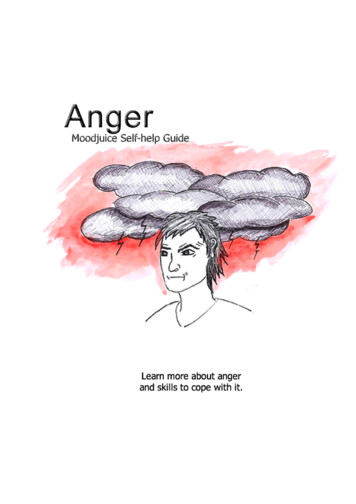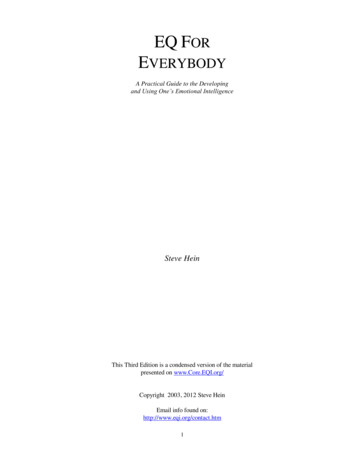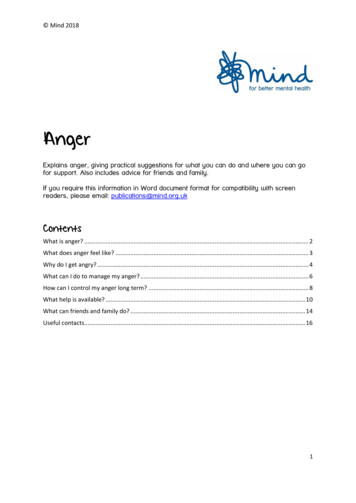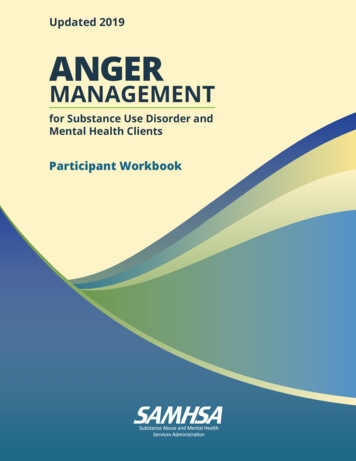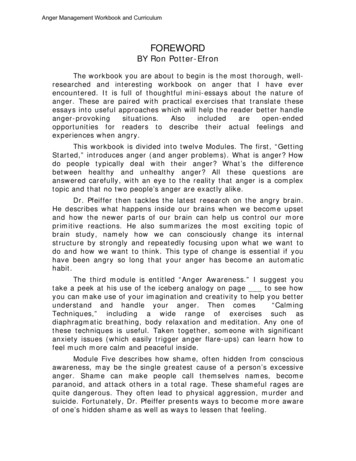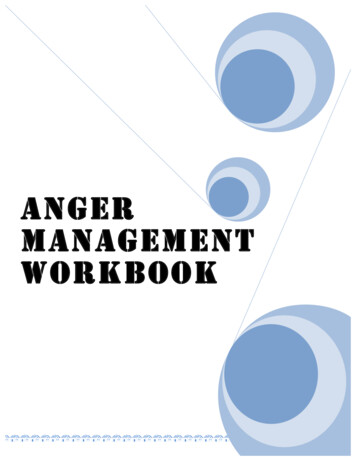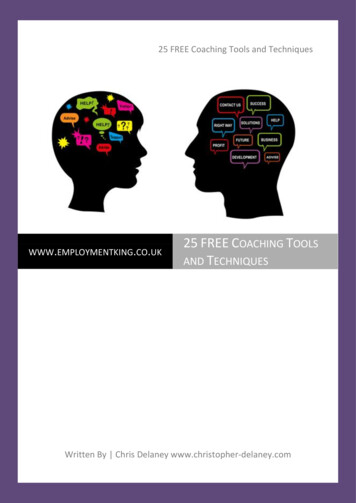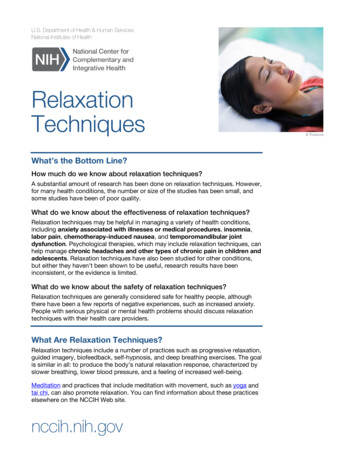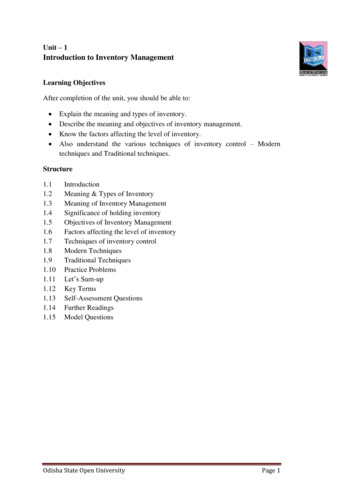
Transcription
ANGERMANAGEMENTTECHNIQUESByWilliam G. DeFoore, Ph.D.
Copyright 2007 William Gray DeFooreAll rights reserved.No part of this Ebook may be used or reproduced in any manner withoutwritten permission of the author, except for brief quotations used inreviews and critiques.This book is a work of non-fiction. Any resemblance to actual events, settings or persons,living or dead, is entirely coincidental.Produced in the United States of AmericaFirst edition 2007Most recent update 2014 William G. DeFoore, Ph.D., www.AngerManagementResource.com2
Table of ContentsPage NumberIntroduction4-5Chapter One: Understanding Anger6-8Chapter Two: Anger Assessment Scale9-11Chapter Three: Quiet Anger Release12-14Chapter Four: Physical and Vocal Anger Release15-19Chapter Five: Emotional Healing Exercises20-22Chapter Six: Healthy Anger23-25Chapter Seven: Anger Communication Skills26-29Chapter Eight: Your Spiritual Power30-31Bibliography32Additional Resources33About the Author34 William G. DeFoore, Ph.D., www.AngerManagementResource.com3
INTRODUCTIONAnger is a natural, healthy emotion. It is simply a feeling you have whenyou are threatened or opposed. There is nothing wrong with having that feeling.The question is: what do you do with it?If you just stuff your anger, you can make yourself sick. If you blow up at others,you’ll have problems in your relationships. In this program, we will look at waysfor you to understand, manage and express your anger so that it is an asset toyou and not a problem for you, your loved ones, or associates.You may already know that you have a problem with anger. If you’re not sure,here are some things to consider:Indicators That You Have An Anger Problem When you get angry, you don’t get over it. Sometimes it lasts until youexplode, or it may go inside to fuel the fires of your rage. You may be one who holds a grudge. This is not doing you or anyone anygood. Maybe you never get angry: you just don’t have the emotion. There aretimes when you know you should be angry, but the emotion just doesn’tseem to come. Your anger is watered down and you never fully release it.This will lead to other emotional problems and possibly illness as well. You may be someone who feels frustrated, disappointed or irritable muchof the time, but you really never show your anger. Anger may be anunacceptable emotion to you, whereas frustration, disappointment orirritability are acceptable. This can interfere with or prevent anymeaningful level of fulfillment or joy in life. William G. DeFoore, Ph.D., www.AngerManagementResource.com4
Perhaps you are sarcastic or cynical about yourself, others or the worldaround you. You may tease others with velvet daggers in some of yourjokes, only to be surprised when they don’t want to be around you. Youdon’t openly express anger but it is leaking out all of the time. This canlead to tremendous unhappiness for you and those who are close to you. You may be someone who feels depressed frequently, or for long periodsof time. You don’t express anger openly but tend to take it out on yourselfwithout even realizing it. This can lead to suicidal thoughts and behavioror perhaps major illness. You may be someone who is angry all of the time. You may be verbally,emotionally or physically abusive to others in personal and professionalrelationships. This doesn’t mean that you are a bad person but it certainlymeans you need to learn to manage your anger. If you have indeed beenabusive, it is almost certain that you will need professional help to workthrough your problems with anger. The important thing is that you don’tgive up on yourself with thoughts like, “That’s just the way I am.” If youhave the will to change, you can change.Like many people, you may feel powerless in your own life—powerless to makethe changes you choose to reach your goals. Though you may not use the word,you possibly feel like a victim much of the time. You may have many ways toexplain why you can’t live your dreams, all of which seem very reasonable toyou. The point is that if you are denying your power by denying your emotions,you are getting in your own way. To claim all of your emotions as your allies,and to express them in healthy ways is to maximize your resources for your ownexpression of purpose in life.I want you to consider something: you have good reason to be angry. How youexpress it may be unreasonable, but that doesn’t mean you don’t have goodreasons for it.Possible Reasons For Anger We get angry because we’ve been hurt in some way, and we are afraid ofbeing hurt again. We get angry because we don’t get our way and maybe we are used togetting our way. We get angry because that’s what our parents did. We may get angrybecause deep inside we remember being abused, neglected, or William G. DeFoore, Ph.D., www.AngerManagementResource.com5
abandoned in some way and we are afraid of it happening again. We may even be angry because of a loss we have experienced and we arenot through grieving that loss.These are all good reasons to be angry, yet they are not good reasons for harmingyourself or anyone else. Anger doesn’t have to hurt. In this program you willlearn about healthy anger and how to express it in healthy ways. William G. DeFoore, Ph.D., www.AngerManagementResource.com6
Chapter One:Understanding AngerAnger, Your Body and Your BrainYour anger lives in your body. You’ve heard the phrase, “Talk it out” as arecommended way of resolving anger and other problems in relationships. Thisworks, but only if the physical and emotional components of your anger areunder control.When you get angry, your body might get hot, your muscles tense, your heartpound, and your thoughts race. This is not a time for trying to talk to somebodyabout your feelings. They won’t want to listen. By itself, anger is not a goodcommunicator. As a pure, raw emotion, anger only wants to control the threat orthreatening person.Have you ever noticed how when people are really angry, they’re not all thatsmart? Well, this is true for all of us. In extreme anger or extreme fear, we’re justnot as intelligent as we are when we are calm.In his ground-breaking book, Emotional Intelligence, Daniel Goleman explainshow extreme emotion can actually shut down the higher functions of the brain: aprocess he calls emotional high jacking. This is where strong emotions interfere William G. DeFoore, Ph.D., www.AngerManagementResource.com7
with good decision-making. This is where good people end up hurting the onesthey love or doing things they later regret.When you find yourself feeling angry, it’s time to take care of your own internalphysical and emotional needs first, until you can relax enough to think clearly. Ifyou don’t take care of your emotional situation, you won’t do a good job oftaking care of your loved ones or the problem at hand. Only when you haverelaxed and regained full access to your brain’s capacity can you begin tocommunicate and problem solve effectively.All of your emotions live in your body, and your mind is an interpreter trying tomake sense of the powerful feelings pulsing within you from your head to yourtoes.Your anger started out as your friend. It was originally a protective emotiondesigned to keep you safe. When your anger is healthy, it can make you strongerand more effective. When it is unhealthy, it can destroy your life andrelationships. Fortunately, the choice is yours.So how did your anger become a problem? Well, it was not your fault. You mostlikely had poor role models, because in most cases our parents weren’t any betterat dealing with their emotions than we are. This is true of even the best ofparents, even those who show no emotion at all. Another way that angerbecomes a problem is when it is punished. You may have been hit, shamed,yelled at or sent to your room when you showed anger as a child. If any of thesethings happened to you, it may have been difficult or even impossible for you todevelop healthy anger.A Healthy Response to a Child's AngerTo give you an example of how a parent might respond to a child’s anger in ahealthy way, consider the following:You are 3 years old. You are in your high chair by the kitchen table, and there is asmall plate of mashed peas in front of you. To show your distaste and to test thispower that seems to be rising from within you, you scream one of your bloodcurdling screams and shove the plate and its contents onto the floor. The peassplatter onto the freshly painted white wall.The emotionally healthy parent comes over and says, “Wow. You didn’t wantthose peas, did you? Look what you did. Now the peas are all over the wall andthe floor. You were really angry. Now I'm going to clean this up, and you stillhave to eat some peas. It’s ok for you to be angry but it’s not ok for you to throw William G. DeFoore, Ph.D., www.AngerManagementResource.com8
your food on the floor. I feel sad about this mess on the wall. Let’s get thiscleaned up.”The healthy parent says this in a friendly, surprised tone with no anger orshaming of the child. The child’s emotions are being acknowledged andaffirmed and the consequences for the child’s behavior are clear in the parent’ssadness over the mess and having to clean it up. The child also has to eat thepeas.This is not what happened when you got angry as a child, is it? As I mentioned,it is not your fault if you have anger problems, but it is completely yourresponsibility to deal with them now that you’re an adult.Let’s do some things that will increase your response-ability (your ability torespond in healthy ways) to situations that trigger your anger. We will approachanger here from two different angles:1. You will learn specific, practical and healthy ways to manage, release andexpress your anger in relationships, and2. You will learn ways to address the underlying causes of your anger sothat your behavior changes are lasting and permanent.Let’s start with the practical skills. These are some simple exercises you can useto release the physical tension associated with your anger. By learning andpracticing these skills, you will be able to lower your stress and clarify yourthinking before attempting to communicate.First, you need to know where you are with your anger control at this time. Youcan use the following 0-10 anger scale to assess and monitor your anger level.When you develop an awareness of your anger level you will be better able tomake choices before it escalates out of control. You may find that you can stillmake good decisions up to level 2 or 3, and after that the emotions start takingover and interfering with clear thinking. William G. DeFoore, Ph.D., www.AngerManagementResource.com9
Chapter Two:Anger Assessment ScaleHere’s how the scale works:Level 0: You’re feeling totally calm and relaxed. You may feel happy and excited.You have no anger or irritation at all.Level 1: You feel a very slight anxiety or irritability from time to time but it’s notaffecting your behavior. You can barely notice it when you try. Your mind isopen and you are very aware of the big picture perspective.Level 2: The irritation and anxiety is a little higher but still not enough to botheryou or affect your behavior. You can still see the big picture. It is hard to relaxwith the agitation you are experiencing, however.Level 3: You’re starting to have negative responses to people, places and thingsaround you. You’re still keeping your anger inside, but you’re just not settled.Your focus is starting to narrow slightly, but you can still think clearly and makegood decisions.Level 4: Now you’re starting to think about yelling at that other driver, or callingthat talk show host and giving them a piece of your mind, but you don’t act onthe feelings. Your tone with others might be just a little short, or you might try to William G. DeFoore, Ph.D., www.AngerManagementResource.com10
cover your feelings by being extra nice. Tunnel vision is starting to set in. Youhave a hard time not thinking about what you’re mad about.Level 5: Now you’re definitely not having fun. You’re mad at yourself, others, orthe world in general. You’re still in control of your behavior, but others can tellyou’re not feeling that great. You become grouchy and irritable with the peoplearound you. You’re moving into a single minded focus and your decisionmaking process is impaired.Level 6: You start thinking about getting away from some situation that isbothering you. You might fantasize about escaping somehow. You might alsotell someone off at this point but you make an effort to be controlled, and evenconsiderate. Your mental clarity has become erratic. You have lost sight of the bigpicture.Level 7: You’re starting to say things to yourself like, “This is driving me crazy. Ican’t stand this anymore. That person is driving me up the wall. If I could, I’dlike to really let them have it.” Your thoughts are racing and your muscle tensionis becoming noticeable. Your vision is narrowing further.Level 8: At this level, a plan of action starts to form. Now your anger is so highthat you’re ready to do something about it. You’re so upset that you really haveno choice. You’re thinking is not clear, and your plan of action might includerevenge and retaliation, or just a desire to hurt someone you perceive as a threator a problem to you or someone you love. You have become almost completelyirrational in your anger.Level 9: Now you’re acting on your anger. You’re telling someone off andpossibly trying to hurt them or put them in their place with your words. You alsomight be planning how to abandon, neglect, or reject them. At this level yourthoughts are obsessed and totally focused on your pain, fear and anger whetheryou know it or not. You are ruled by your emotions at this level.Level 10: At this point you have become dangerous to yourself and others. Youare in the depths of fight or flight and your primitive, survival based brain hastaken over. You have tunnel vision and single minded thought. All you can thinkabout is how to make the pain or stress stop. It is a very helpless feeling. You aredesperate and willing to take desperate action. Your fear and anger are nowdoing your thinking for you. William G. DeFoore, Ph.D., www.AngerManagementResource.com11
Rate yourself:At my best I am--fill in the number(s)At my worst I am--fill in the numers(s)Most of the time, I am--fill in the number(s)If you have major anger issues you may escalate straight from 0 to 10 withoutany awareness or self control. If you have successfully suppressed your angeryou may live constantly at a level 3, 4, or 5, never taking action or feeling anybetter. Many people are mildly irritated much of the time. Being emotionallyhealthy means living around a level 0 to 2 most of the time. In extremecircumstances a healthy person may escalate to a level 3 or even a 4, but will takepositive, effective action to resolve the problem and return to a sense of wellbeing.See which of the following categories best describes you:1. MILD ANGER ISSUES: Most of the time you are around a 2 or 3, but all toooften you jump up to a 5 or 6--or even an 8 once in a while. A few times in yourlife you may have reached a 9 or 10, but you're determined never to go thereagain. Reading and CD's may be enough to help you reach your goals.2. SERIOUS ANGER ISSUES: You have to struggle almost daily not to loseyour temper. You can jump pretty fast to a level 8 or 9. You have reached a 10 afew times, but most of the time you can prevent that. You haven't hurt any onephysically, but you are definitely hurting others with your words and actions.You may need professional help in addition to reading and listening to CDprograms on anger management.3. EXTREME ANGER ISSUES: Your anger has control of you most of the time.People around you are not safe emotionally or maybe physically, and manytimes you endanger yourself as well. You may escalate from a 3 or 4 (yournormal level) to a 10 in a heartbeat. Your anger is running your life. Youdefinitely need professional help, in addition to reading and listening to CDprograms on anger management.4. EMOTIONALLY HEALTHY: You live around a level 0-2 most of the time. Inextreme circumstances you may escalate to a three or even a four, but youconsistently take positive, effective action to resolve the problem and return to asense of well-being. William G. DeFoore, Ph.D., www.AngerManagementResource.com12
Chapter Three: Quiet Anger ReleasePrivate, Non-social Skills for Anger ManagementPlease be aware that any exercises that you try from this program are undertaken at yourown risk. If you have any doubt whatsoever as to your emotional readiness or mentalstability in practicing these skills, please consult a qualified professional before actuallyattempting the exercises.The first thing to do when you’re extremely angry is to release the physicalenergy of your emotion or blow off some steam. This can be done in severaldifferent ways, some of which you can do anywhere and others that need to bedone in private.Your anger management skills need to include some non-aggressive, sociallyfriendly methods of anger release—for example, in traffic, in a public place, or inthe presence of someone who would be hurt by your anger if you just let it out.Here are some methods for managing, processing, or releasing your anger whensome kind of physical or vocal expression wouldn’t work well. Pleaseunderstand that these methods will not work for everyone. There is a time andplace for each of the different types of anger control, release, and expression.1. Breathe into your anger and let the emotion expand outward into yourbody. Do this by imagining that the energy of your anger is getting biggerand bigger. Imagine your anger as a cloud, a fire, a fist, or whatever worksbest for you. Breathe deeply into your stomach and exhale slowly as youfeel and imagine this image getting bigger and bigger until it expands William G. DeFoore, Ph.D., www.AngerManagementResource.com13
outside your body. See it and feel it coming out of the pores of your skin,off the tips of your fingers and outward from your body in everydirection. Keep going with this process until the image of your anger getsso big that it disappears entirely.2. Create an exaggerated image in your mind of someone or somethinggiving full and complete expression to your anger. It is essential that thisimage not include violence toward people or animals. The use of imageryis a form of rehearsal, and can in some ways perpetuate behaviors similarto what is being imagined. Here are some examples of images that haveworked well for others: Imagine a tornado ripping across an open field. Let the power ofthis force give expression to your emotion. Feel your anger beingreleased by the movement and dynamic energy of the tornado, andwatch it as it slowly subsides, harming no one. Picture a gigantic being thrashing about, grabbing thunder boltsfrom the sky and tossing them into huge black thunderheads. Letthe thunderheads be your problems and the thunderbolts oflightning be your insights and healthy anger. Follow this processuntil you feel a release. Imagine that you are a martial arts master taking charge of asituation without harming anyone. Use your focus, determination,and clarity of purpose as your power. Work with this imageryuntil you see a powerful resolution to the problem. Become a magnificent dancer in your mind’s eye: swirling,sweeping, swooping and flying about; twirling and spinning withtremendous energy and power. As you move, feel the power ofyour anger being released in your movements.3. Send love and justice to the person or situation toward which you feelanger. Imagine that the power, clarity and justice of perfect love is shininglike the brightest of all lights directly on and into the person or persons,requiring that they face the truth and reality of their actions. Watchsobriety and realization dawn across their face as the light of justiceprevails. For example: In a road rage situation, see the driver that is endangering his ownand others’ lives being pulled over and getting a huge ticket orhaving his license revoked. Or picture this dangerous driver having William G. DeFoore, Ph.D., www.AngerManagementResource.com14
a near miss that serves as a wake up call. Watch his face as herealizes the insanity of his actions. Imagine deep truth and clarity dawning across the mind of thetyrants and abusers that have wrought terror and suffering onyours and others’ lives. Watch what happens in their eyes asperfect love is revealed and justice is done. Picture the friend, spouse, family member or associate "getting it."In your mind's eye, see them realizing their part of the problem andshowing a willingness to take responsibility. Whether you believethis will happen or not, this exercise will be good for you and therelationship.4. The first chance you have after your anger has come up, write or journalabout your feelings. The main point to emphasize about this technique isto let the angry part of your mind have full and pure expression on thepaper, holding nothing back. Don’t censor or edit yourself here or youwon’t get a full release. Also, don’t be reasonable or civilized in yourwriting. No one is supposed to see this but you, and you already knowwhat’s been in your head anyway. This uncensored writing allows a morecomplete purging of your anger, and gives you a chance to see the depthsof your emotion clearly. It also gives you a place to put your anger: out onthe page where you can look at it consciously and examine it with yourlogical and reasonable mind. William G. DeFoore, Ph.D., www.AngerManagementResource.com15
Chapter Four: Physical and VocalAnger ReleaseNow let’s talk about some methods of releasing your anger physically andvocally. The space and materials needed for these exercises are usually availablein most homes.Here are some things to consider in preparation: A mattress or large, overstuffed pillow is usually helpful. If you’re usingan exercise mat, you definitely need a pillow as most mats are just not softenough. It is very important that you not hurt yourself while doing theseexercises. After all, the point is to provide an experience of expressinganger in a way that doesn’t hurt anyone, including you. These exercises need to be done in private, unless you’re with a trainedprofessional or in a therapy group with a professional present. Yourfamily and friends usually won’t understand, and you don’t need to haveanyone questioning you during this process. As much as possible you need to feel emotionally and physically safe.The best thing is to be alone in your home during these exercises unless William G. DeFoore, Ph.D., www.AngerManagementResource.com16
your spouse or roommate understands and supports the anger work. Some people do anger work alone in their car. Although this is better thantaking it out on another person, it can be dangerous and I don’t advise it.If you feel you are going to explode, however, it may be healthier toscream alone in your car than to suppress your anger and hurt yourself orstuff it until you explode at someone you love. I strongly recommend thatif you do this, at least stop your car first. A piece of equipment useful in anger release work is a bataca bat,sometimes called an encounter bat. These are foam-padded bats that canbe ordered through special supply houses that handle therapeuticequipment of this nature. Tennis rackets also work well for this exercise.The bat or racket is sometimes helpful to people with back problems thatmight have difficulty hitting a mat or pillow with their fists or arms. When using any of these items it is wise to wear gloves to avoid causingabrasions. If a body bag or sand filled canvas punching bag is used, it isimportant to use some type of gloves to avoid scraping the skin off of yourknuckles. Using gloves may also be necessary if hitting a vinyl mat withyour clenched fists. The upright bag, either suspended from the ceiling or leaned into a corneris sometimes helpful for those who would rather stand than kneel in theanger release process. If the bag is suspended from the ceiling, it needs tobe somehow anchored to the floor. This is to prevent the delay in yourrelease work as you wait for the bag to swing back in your direction. Toachieve a complete release, you need to be able to have a full blownexplosion, and this can’t be accomplished if you have to wait and planyour blows to a swinging punching bag. Also, keep in mind that these bagsare called "body bags," because they are made to resemble a human body. This canbe seen as a rehearsal for violence for some people, and should be avoided if there isany risk of that.Here are some particular exercises you might try:The Power PositionI refer to this technique as The Power Position only because I have seen so manypeople claim their power over their lives and emotions while using this method.The Power Position first involves kneeling on the end of a bed, mattress or softmat. Your knees should be on the mat or pillow, not on the floor. Many peopleare not accustomed to resting their weight on the knees and a cushion helps torelieve some of the pressure. This position is difficult or impossible for those William G. DeFoore, Ph.D., www.AngerManagementResource.com17
with back trouble and it is necessary to be aware of these types of problemsbefore trying this technique.If you have any health concerns regarding this exercise, please consult your doctor orhealth care professional.After you kneel on the mat, raise your arms directly over your head, make fistswith both hands, and come down on the pillow or mat as hard as you can asmany times as you can until you feel a release. I recommend that you strike theactual blow with the entire lower arm from the elbow to the fist. This allows for amore powerful energy release than just using fists. You can also use the bats orrackets discussed above when using The Power Position.If you grow tired, take a break and try again until you feel that satisfying reliefand release. The Power Position can also involve standing over a bed or othersoft structure about waist high and using an object to hit with. In some cases,however, you can safely use your fists or open hands when standing.The Temper Tantrum TechniqueThis posture for anger release allows a full body rage release that seems to godeeper into the subconscious mind and the body. If you’re having difficulty withthe Power Position or if you have used the Power Position several times and stillhave not reached the bottom of your rage I strongly recommend this technique.This method of rage and anger release involves lying on your back on a mattressor mat that is wide enough to allow at least 8-12 inches clearance on both sides ofyour body. This provides space for pounding with both hands without going offthe mat. While releasing anger in this way your body will sometimes drift off toone side or the other, or up or down on the mat or mattress. If the mat does notallow enough room for this, you may go off the edge or ends of the mat, whichwill interrupt the flow of your emotional release. Simply try to stay centered sothat this doesn’t happen, or have someone assist you to keep you centered.Begin by closing your eyes. Then raise your feet up on the mat so your legs arebent and your feet are flat on the surface of the mat. The next step is to beginpounding alternately with both hands and kicking with both feet. For mostpeople this involves hitting with the right fist while kicking with the right foot,then hitting with the left fist while kicking with the left foot. For a full release,you need to do this as rapidly as possible until your emotions take over and youdon’t have to think about what you’re doing at all.Usually not much instruction is needed for this since the subconscious mindremembers everything, including how to throw a good temper tantrum. And William G. DeFoore, Ph.D., www.AngerManagementResource.com18
yes, everyone feels silly and embarrassed at the very thought of doing this. Thequestion I ask is, how silly does it feel to yell at your family or friends? How sillyis it to land in jail because you can't manage your anger? How silly will you feelwhen you have created an ulcer or heart trouble from repeated anger problems?Try pushing through your embarrassment and see if you can take out some ofthat anger on a pillow or a mattress instead of yourself or people you love.Vocal Methods of Anger ReleaseI want to talk specifically about the vocal parts of anger work for a minute. Yourvoice has always been a primary means of expressing your emotions and yourself. It is the suppression of emotion and the suppression of self that leads to theneed for anger release work.Many of us were told to shut up or be quiet as children and we need to overcomethis message to our subconscious mind. In doing anger work we are not onlybeginning to reclaim our emotions, we are beginning to reclaim ourselves.Deep vocal release of anger is best accomplished with the process beginning witha growling exercise that helps to relax the throat muscles. The desired roaringeffect that provides the greatest emotional release and experience of power isthen achieved by forcing greater volume of sound into the growl until it becomesa roar.Many people prefer doing their roaring into a pillow so they are less inhibited.This can be a highly effective form of emotional release in many cases and couldhelp to relieve stress and prevent anger outbursts toward others.It is also a good idea to use words in vocal release at times. Words and phrasescapture emotion and when verbalized during anger work, they can provide apowerful release of pent up emotion. Here are some phrases that have workedwell for a lot of people, and which you might find helpful.I’m angry!You were wrong!It wasn’t my fault!Stop it!It can also be helpful to claim some power and freedom with statements l
This is where good people end up hurting the ones they love or doing things they later regret. When you find yourself feeling angry, it’s time to take care of your own internal physical and emotional needs first, until you can relax enough to think clearly. If you don’t take car
